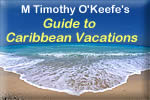The Heritage Collection, Anguilla |
A nifty local history museum. Who knew the island once rebelled and Britain had to send in troops--in the 1960s? |
||||
|
The artifacts and historical documents of this small private museum span almost a thousand years.
The oldest artifacts were made by Arawak Indians between 800-1000 AD. These include 3-pointed stones that were believed to have served as personal "power objects;" stone axes; and shell and conch necklace pieces.
Some items, such as clay pipes from 1820, depict plantation era life. However, most visitors are intrigued by the utensils and clothing objects the islanders ingeniously created to meet the need of their times.
Such as the "old wife skin," the rough skin of an "old wife fish" used to scrub utensils like pots and pans before the advent of commercial scrub brushes.
Sandals (called "spatalashes") were made from car tires for walking on the sea rocks and on the roads. Sea fans were used as flour sifters. The intriguing collection was assembled by Colville Petty, OBE, who served as deputy governor and acting governor of Anguilla. Petty also authored several books about Anguilla's history. The materials end with Anguilla 's revolutionary period--the 1960s. Most visitors are surprised to learn that tranquil Anguilla was a hotbed of political unrest during that period. Britain had imposed a federation with St. Kitts, but Anguilla felt St. Kitts was hoarding all the power and money.
In 1967, Anguilla rebelled, becoming known as the "eel that squealed," a term derived from a movie popular at the time, The Mouse That Roared.
Political tensions gradually increased until 1969 when British troops were sent in. Anguillans were happy to see the troops and sang "God Save the Queen" on their arrival.
Anguilla wanted to remain a Crown Colony of Britain. The ties it wanted to cut were with St. Kitts. Which is how everything played out.
One of the photographs taken during the rebellion shows museum owner Colville Petty himself greeting British troops. Other items displayed from this period are the front pages of newspapers, a riot shield and helmet used during the British police action.
"History is my hobby," explains Petty, who started collecting in 1978. "I used to house everything in my study but it pushed into another room and into my one-car garage."
Petty says he never intended to make his collection public. When word spread about his historical treasure trove, he realized how many people wanted to view his collection, so he put it on display in 1996. He's glad he did.
"A lot of our history disappeared when the plantations did. It's important for an Anguillan to know from whence they came, especially the young people. If they understand our history, there will be a better chance to enhance the unity of our people," he believes.
Petty tried moving the museum to a more central location but now it's back at East End, across from the East End Pond Bird Sanctuary. Open Monday-Friday from 10 a.m. until 5 p.m.
For more information, call 264-235-7440; or www.offshore.com.ai/heritage. There is US$5 per person admission fee for adults, US$3 for children. Plan on spending at least an hour.
|
|||||
